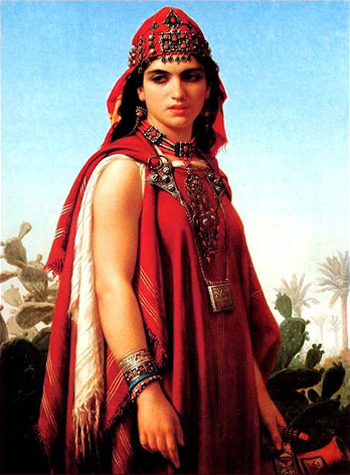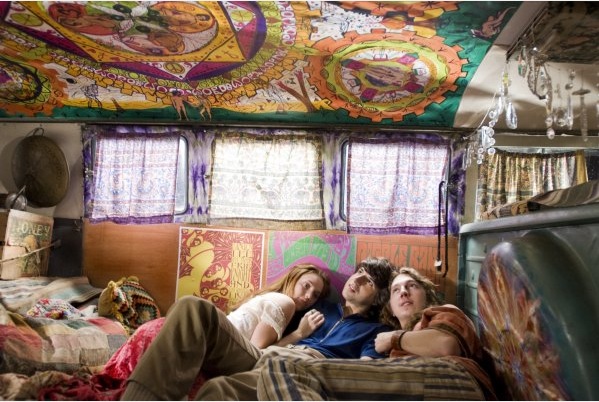Esteban Belle au Parfum de Oud (2012): Western Oud Time-Travels to the 70s {Perfume Review & Musings}

Femme Amazigh / Amazigh Woman by Emile Lecomte-Vernet, 1870
You could not mistake Belle au Parfum de Oud for anything but an Oriental. It plays upon a palette of deep, warm and coded notes as surely as an Orientalist painting does. Here, the rear view from a latticed window is replaced by a woody accord with both fruity and woody olive nuances reminiscent of a facet of Argan oil - the ever popular new beauty product which has made its mark - just like oud has - on the European - certainly French - beauty and perfume cultures.
The heavy fold of a brocaded tapestry or toga has been replaced by a headshoppy patchouli sure to woo nostalgics of the 70s with the psychodelic accents of the decade and remnants of hemp memories. The brass tables covered with sweetmeats and lokoums have been substituted with a sweet, creamy impression of leather...
The new scent composed by young perfumer Emilie Bouge is like a sophisticated version of an Oriental oil. It is not overly complex, but it is not as simplisitc as an oil either. It retains however this quick-trip-to-Kathmandu aspect that you get from some scents and incense sold next to mood rings in Tibetan artifact stores.
Yes, we know, you may point out that Kathmandu is located in Nepal. The local reference here is that those whiffs of Oriental wisdom are often sold by Tibetan immigrants, at least in the Boston area. And this is the picture that the perfume conjured up for us, thanks probably to the note of nagarmotha, a material used to perfume saris and clothing in India, which are abundantly imported in these stores...
The fragrance smells cheapish, but authentic on a sociological level. The perfume does not actually feel cheap but alludes to that range of sensations. While the brand stressed the Western lineage of the fragrance, one feels it can be felt in the construction more than in the style of the perfume which remains convincingly untouched by a desire to emulate a Dior or a Guerlain. If Western lineage there is, it is about history more than about a school of style. But is this perfume really about what one expected it to be?
The fragrance is part of the new collection Empreinte (Trace) by Esteban, which aims to capture olfactive memories buried deep in our (collective) subconscious to make them come swim up to the surface again. Belle au Parfum de Oud seems less to jump onto the oud bandwagon of the first two decades of the 21st century ( see M7 by Yves Saint Laurent) as go back to a major reference of our Orientalist past, Woodstock & al. It makes sense if the goal of the Empreinte collection is to be turned towards the past rather than the present - oud is too recent of an olfactory mainstream newcomer to be part of our hidden subconscious. This is why - we get it now - this oud composition was said to be "more than about oud". This is why there is a lot of patchouli in it, of the earthy, wet-crypt, Marijuana-masking variety to echo the perfumistic eloquence of the 70s.

You expected to get lost in the contemplation of a painterly classical beauty of the Orientalist school as the name of the perfume suggested, instead you are invited to think of "beautiful", happy-to-be hippies, including the note of dirty hair, courtesy of Costus. The discreet floral nuances make you think of the flower people. And the chocolate note seems to be taking a quote from a cannabis-spiked brownie. You are not in a gallery of Orientalist paintings after all, but rather in a movie-theater watching Taking Woodstock by Ang Lee (2009). The nagarmotha or cypriol contributes to a nuance of luxury - the rustling of silk saris - but ultimately brings you back more to a cultural ambience rather than insists on conveying an upscale sensation.
The bandaid-y nuance of oud reinforces the commitment of the belle or beau who wears this perfume to a nostalgic past when it was believed that essential good things, wise things and revolutionary things came from the East. In this sense, there is a justification for using oud to re-interpret a similar cultural bridge as established yesterday and today since oud has become such a fixture in Western perfumery. It's adding a new, much more common Oriental note of our day to the repertoire of the (revivalist) 70s when oud was not iconic of the period like patchouli or musk were.
It is therefore about adding a supplementary layer of meaning to the language of perfumery. That language does not reflect anything but an inspiration. It offers a twist on the patchouli mythology, not on East-West relations today. It's really about adding more depth to perfume as a bank of memories through the act of layering olfactive meaning. And if perfumery is not about layering, it is not what's it's purported to be: portable liquid memory.
For another 70s, revivalist hippie perfume see Vintage by Kenzo .









